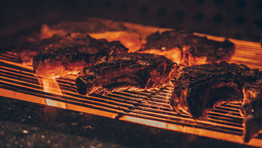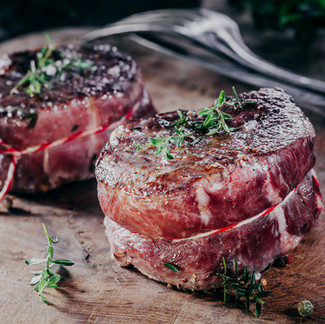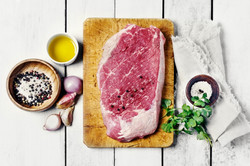Cooking a Great Steak! Part I
- Chef Savant

- Apr 17, 2020
- 10 min read
Updated: Jun 12, 2022
For those of us that enjoy the experience of a great steak, when it comes to preparing one ourselves, its not always as easy as it looks. Developing the flavors of a sumptuous steak so delicious, that you wouldn’t dare insult it with the mention of a steak sauce. You know the one; that steak that gets you to reminiscing back to that flame kissed sear, followed by symphony of flavors bursting with each chew, leaving just a hint of smokey char essence lingering, on the tongue... as you're transported to a space where time stands still, just long enough for you to enjoy the making of blissful memories of sultry culinary beefiness... yeah, that‘s the steak experience we’re referring to!
Now contrast that, with the lesser experience of having a steak with a bite so tough that it requires a hacksaw and a pair of pliers, along with endless mauling and the loosening of a few good teeth, and finally face cramping from continuous, chewing... leaving you to feel exhausted from an epic defeat. Definitely a steak experience that bears no repeating.
Yes, as a steak lover, then you’ve likely had both experiences during your hunt for a great steak, leaving you to wonder, instead of paying for a bad experience, why not try your hand at making one yourself? Well, fear not, the Culinary Savant is here to help you do just that!

Based on a few comments and requests from our readers the vast majority seem more interested in learning to cook steak in single portions as opposed to cooking a Roast like a prime rib or a “steamship round” which is often used for carving at buffets and Sunday dinners. Being as large as they are, these obviously take longer to season and prepare and simply have less practical applications for an everyday portion when cooking at home.
More often then not, though, when we’re in the mood for steak, we may choose to outsource our options instead of preparing it ourselves. Maybe the concept of preparing a great steak feels too daunting or perhaps we feel like we don’t have enough intel to negotiate the outcome! Either way, we’re here to help you and to do this we’ll address the subject in 2 parts. Namely, understanding how to choose and prepare a great steak, followed by, choosing great side dishes that will compliment and enhance your overall experience. Fair enough?
So to begin, we’ll start with a little direction on choosing the best steak. As a rule of thumb, the most lean and tender cuts of the beef will come form the “loin” family, i.e. Short loin, Sirloin, Tenderloin, etc.
Also the tendernss of the steak will depend much on the marbling within the meat and how long its exposed to the heat. The thicker the cut, the longer it will take to cook and the lower you want your heat, so that it doesnt cook too quickly on the outside while being undercooked near the middle. The marbling will play a key factor in how juicy each bite will be. As the steak is cooked, the marbling will melt into the fibers of the meat, helping it to retain moisture throughout the cooking process and will add flavor to the sear when eaten.
It’s also important to know a little bit about the grades of the beef itself. Understanding how the grades are processed and the different classes within the grades and all of the “riveting” information that goes with it, is a science all to itself. We’ll keep it simple though, and focus mainly on the 3 most commonly seen grades, namely Select, Choice, and Prime. Do note that, there are in fact other categories to purchase from, but by and large, these are the most common grades found in most super markets! Think of them this way... Select ($)/ is an okay grade... Choice ($$)/ is a grade that goes from decent to pretty good... and Prime ($$$)/ is a grade that goes from pretty good to great, and offers a more consistent level of quality from the 3 in this grouping! As for the grades beyond Prime well, they range from great to superb can cost a premium,($$$$$), and grades lower than Select, well, you wouldn’t be purchasing those anyway, so we won’t even discuss them...
So now that you know the grading scale, it’s time to choose your steak. When choosing a steak one of the first things to look for is the color of it. Steaks can vary in the actual color of redness of due to the different amounts of oxygen present in the actual muscle, which affects how bright or dark the color will be; but its important to note that color alone doesn’t determine if a steak is considered fit for eating or ready to be discarded. However, color combined with appearance and smell, does! An example of a bad combination of colors and appearance would be, if a steak has white spots, or a slimy appearance. At this stage its likely that the steak will have a sour smell also, which is a glaring indicator that, it should not “pass go”, and should be discarded immediately. In efforts to avoid any cross contamination, make sure not to allow any juices for said “bad steak” to leak onto any other foods or surfaces, as this can contaminate other foods as well, and ultimately make for a very bad day!
Having said that though, its also important to note that a steak that has a darker color or that appears to be a little dry, and not bright red, doesn’t necessarily mean that it too has gone bad. In fact, sometimes popular steak houses will serve what they call “dry aged” steaks. Dry aging is basically an aging process that develops deeper richer flavors in the fibers of the steak while causing it to have a darker appearance, which looks much less appealing, at first glance, as shown below. The end product though makes for a very distinguished steak flavor, unmatched by anything you can typically purchase in a local supermarket market.
For all intents and purposes, in principle, you can liken the flavor development of this process, to allowing freshly picked fruit to ripen and become sweet as it sits for a short time. You probably shouldn’t attempt doing this yourself though, as the process does require a certain level of “care and understanding”. So unless you have the space and equipment for it, its best to leave the dry aging to the professionals, or, where possible, try to purchase cuts that have been dry aged for you! But let us digress...
Once you’ve determined that you have a good steak and it is indeed ok for cooking, the next thing to look for, is the thickness of it. This will be a determining factor in how long you’ll need to cook the steak to reach the desired temp or doneness, which is where a lot of us creat the “faux pas” of overcooking our steak by overlooking the “carry over cooking” rule which, in the end, will affect the general tenderness and the overall chew of the texture.
No Overlooking, the Carryover Cooking!!!
Carry over cooking, allows the residual heat to slowly finish cooking your steak, as it begins to rest, and allows the jus from the marbling, to be re-introduced into the fibers of the steak, which helps to keep it from drying out!
So now its time to determine how you intend to cook the steak; i.e. will you be searing or grilling your steak. The desired flavor you’re planning for will ultimately be the determining factor in the end, just remember though, too much heat and you’ll have leather, too little heat and you’ll have rubber; one is a bit dryer than the other, but neither are fun to chew. While it is true that choosing the right seasonings for a steak can make a big difference in the way it pairs and finishes on the palate, it cannot be over stated that choosing the right cooking method for YOUR palate is just as important, and this is where your personal signature begins to develop and take shape. Some chefs prefer a good sear on a steak to develop caramelization on the entire surface area, while others prefer to grill a steak to capture a bit of the smoke and char in the flavor.
The differences between searing and grilling...
Searing
While both grilling and searing will result in some level of camreliztion, the amount of caramelization will depend on how much of the steaks surface is exposed to the direct heat. When it comes to searing a steak it involves exposing the complete surface area of the steak to the heat, which in turn is seared by the contact surface of the heated griddle or pan. Restaurants do this with what they call a Flat Top, which is a type of griddle, but when doing this at home, a sauté pan or a cast iron skillet works just as well if not better!
For perspective try to think of the searing process this way. The entire surface area of the steak could be likened to the palm of your hand. If you placed your entire palm into a hot pan, you could sear everything from your fingertips to your upper wrist. So in terms of searing a steak, searing works great if you’re planning to go with spices that will need some additional heat to open up and bloom the flavors into the fibers of the steak etc.

A good sear will create a type of crust on the surface and, doesn’t necessarily have to be done in a white hot pan; you can sear just as well over medium heat, which will allow your spices more time to bloom, instead of burning them to oblivion over a heat thats too high. As an added benefit to searing, the juices are collected in the pan and can be used for basting or for creating a pan sauce that can later accompany the the steak when its served.
There’s also a method called Reverse Searing, whereby you place your steak in the oven on a lower temp, (say around 275-300F/135-148C) and removing the steak just before reaching the preferred doneness, and then finishing it in a hot pan (on stove top) to seal in the moisture and to lock in the flavors that were developed in the oven. This method lends great texture in tenderness and works really well if you’re into medium to medium rare temps on your steak.
Grilling

When it comes to grilling, imagine again, using your hand as the surface area of the steak, and placing it onto a large heated fork; what happens is, the space where the fork touches your hand is where the “searing” would be most intense, sort of the way a branding iron works. The surrounding area will still be affected by the heat, but the most intensely seared areas will be marked by the pattern of the fork.
Well, since “Grilling” is usually done over a set of bars or “grill grates” the same branding affect is what sears the steak, leaving a pattern on the surface of the fibers. One of the biggest differences between searing and grilling though is that, as the juices fall through the grill grates, they sizzle over the heat and smoke. And as that smoke rises, it permeates the fibers of the meat to create a smokey flavor to accompany the char affect, that you simply cannot accomplish with the sear. That said, because of the amount of smoke from the steak drippings, grilling is generally done outside (i.e. BBQ) or in a space where their is heavy ventilation.
Seasoning
When it comes to seasoning more often than not, less it more; but the tendency is to overdo it. While some recipes will call for a lot of spices and season blends and marinades etc etc, what they don’t tell you is that they’re often compensating for a lesser quality cut of meat.
The idea is to boost the seasonings with such intensity, that they fool our tastebuds into focusing on the flavor while overlooking the texture and tenderness of the meat itself. And lets not discount that marinades by nature, are designed to tenderize tougher cuts of meat, with the use of acids that help break down some of the fibers. However when added to a cut of meat that, doesn’t require tenderization, that acid will pull out the moisture that will cause the meat fibers to tighten which will result in having, well season leather to serve instead of the succulent, sumptuous tender and juicy steak that you’re going for. So as a rule of thumb, if you’re going to make a marinade for a steak, start with fresh ingredients like onion, mushrooms, garlic etc. and blend them using a little oil but leave out the acid. This will incorporate flavors of the aromatics into your steak, without the affect of the acid to make it tough. From there you can sear your steak over medium heat and capture the flavors of your marinade, or you can grill it and get more of the smokey char flavor, for a “flame roasted” finish to accent the aromatics.
Alternatively your could go with the salted steak method by patting your steak dry and rubbing it down with a little salt, then letting it sit for a while for the salt to do its work. If you do this, be sure to place your salted steak on the bottom shelf of your refrigerator, and leave it uncovered. The reason for this is that a dry steak will get a better sear/char on it and by salting it, you allow the salt to bring out the natural beefy flavors of the steak without drying it out toughening the meat like the acid would.
Leaving it uncovered will allow the moisture to evaporate from the surface but will also pull those inner flavors to the surface so that when you cook it you can keep it simple and not have use for lots of seasonings and spices. Also too much moisture on the surface of the steak will cause it to steam more and carbonized the proteins that are in the drippings which doesn’t do any favors for the flavors of your steak! You can allow your salted steak to sit anywhere from 15- 20 minutes to overnight in the fridge before you decide to cook it.
When its time to cook your steak, take it from the fridge and allow it to come up to room temp instead of cooking it while stiff and cold. While its true you can definitely cook a cold steak right from the fridge, the thing is that a colder steak has the tendency to retain too much liquid within the fibers, and as they begin to heat up, they can cause to sweat and steam, and again carbonized the proteins in the drippings instead of caramelizing the fibers of the steak. Again we cannot overstate the “carry over cooking” rule which will go a long way in ensuring that, as your steak rests, it will redistribute the jus into the fibers of the meat, leaving you with a tender, juicy and flavorful cut of beef! And with that, we’ll leave you to begin exploring your own signature techniques, with your refined knowledge for selecting, seasoning, and cooking the perfect steak!















































Comments